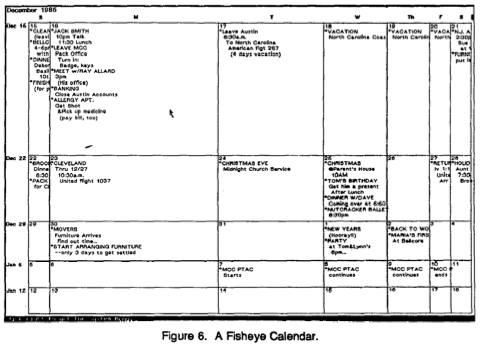
A Fisheye Calendar at Yahoo!
What a difference 22 years make! In 1986, George Furnas published his paper, Generalized Fisheye Views, which described what was to become one of the first (and most prominent) focus+context techniques. One of the examples he used was a calendar that showed the current day in most detail, with less space for the surrounding ones. Yahoo! just started an opt-in beta of their new calendar that uses the same idea.
Furnas observed that people tend to represent their immediate environment (whether physically, temporally, or simply the focus of their current work) in more detail than things that are further away. He called that effect fisheye view, after the fisheye lens that is used in photography and that enlarges objects in the center of the image, while compressing towards the edges (that lens also uses a metaphor for its name, which describes the view fish supposedly see when looking straight up).
Among his examples, he used a calendar. Similar images have appeared in the visualization and human-computer-interaction (HCI) literature since, but Furnas was the first to do this (as far as I am aware).

Now 22 years later, Yahoo! has picked that idea up, made it prettier, and made it useful in its new calendar. The regular view looks just like any other monthly calendar, but when you click on a day, it zooms into that day to give it more room. As a side-effect you also get more space for the current week, as well as for the same day of the week in other weeks of that month (this is sometimes considered a bad thing, but at least for the current week it makes a lot of sense). In this view, you can enter new events and change existing ones (click the image below for full size).
While I don't think that this will lead to a revolution in how quickly companies pick up ideas from visualization and HCI research, it is a good thing that this is happening. Perhaps increased competition, expanded flexibility of programs in browsers, and the pressure to appear cutting-edge will turn more such flash-backs into useful products.
Posted by Robert Kosara on October 8, 2008.


